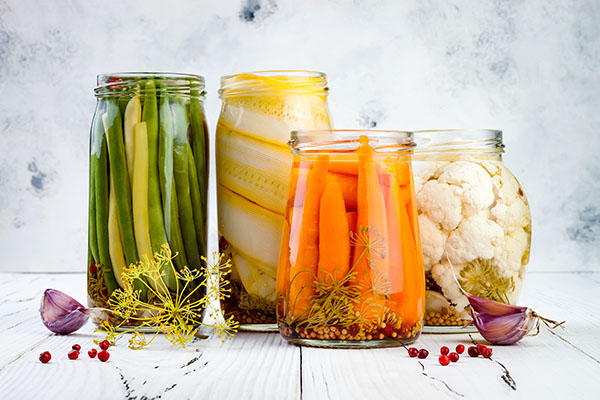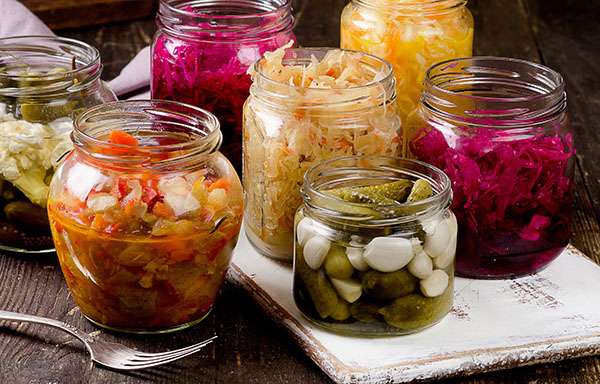
Here are four reasons why you should start eating fermented foods.
Fermented foods are accessible
You may not realize it, but you've probably already eaten fermented foods.
Below are some examples of common fermented foods:
- Cheeses (e.g., blue and feta cheese)
- Pickles (must be made without vinegar)
- Sourdough bread
- Yogurt with live and active cultures
You can also try unique fermented foods like kefir and kombucha. Kefir is a dairy product that you can get in the refrigerated section at your grocery store. If you can't handle dairy, you can drink coconut kefir. Since fermented foods often have a strong flavor, try to start drinking kefir by adding some to a smoothie.
Kombucha is a fermented and fizzy drink made from black tea. While kombucha can help boost your gut health, always check the label. Always buy kombucha with no or low added sugars.
Fermented foods are easy to make
If you're on a budget or if you want to experiment with food, you can make your own fermented vegetables. The process is simple, and all you need is sea salt, water, and your favorite vegetable.
Fermented foods are good for digestion
The average American diet isn't good for your gut health, especially since it can often contain a lot of processed foods that are very hard to digest. Eating fermented foods can improve your digestion and gut health since they contain good bacteria. (Related: Natto, a fermented food from Japan, has enzymes that help prevent heart attacks and blood clots.)
Fermented foods contain more nutrients
When a vegetable is fermented, its nutritional value increases. Fermentation also makes the nutrients easier to absorb since the process helps break down the structure of the vegetables.
Recipe for fermented vegetables
Below is a basic recipe for fermented vegetables that you can make at home. The recipe yields about a quart.
You can personalize this recipe by using your preferred seasonings and vegetables.
Ingredients:
- 4 cups of the vegetables of your choice –washed and peeled (if desired), then cut into roughly evenly sized pieces
- 4 cups chlorine-free water
- 2 tablespoons sea salt
- Seasonings of your choice
Tools:
- Cheesecloth, paper coffee filter, or tea towel
- Measuring cup
- Small jar
- Wide mouth jar
Instructions:
- Fill a clean, wide-mouth jar with the chopped vegetables but leave at least one-and-a-half inches of head space.
- Add your seasonings.
- In a one-quart liquid measuring cup, combine four cups of water with two tablespoons of sea salt. Mix until the salt dissolves.
- Pour the saltwater brine over the vegetables in the wide-mouth jar. Make sure to leave an inch of head space.
- Place a smaller, clean jar (or something heavy) inside the first jar so the vegetables are submerged below the brine.
- Cover the jars with something breathable. You can use a paper coffee filter with a rubber band to hold it in place. Alternatively, you can use several layers of cheesecloth or a tea towel. If you use a tight-fitting lid, you need to open the jar every day to let some of the gasses escape. Another option is to use a lid with an air-lock.
- Let the vegetables ferment on the counter for two to three days at around 70-75 F. Check the jar daily to see if the vegetables are staying below the brine. After several days, tiny bubbles should be forming at the top of the brine.
- Taste the vegetables after two to three days have passed. Once they reach a flavor that is to your liking, remove the weight then cover the jar tightly. You can refrigerate the fermented vegetables until you want to eat it.
Here are some fermented vegetable combinations that you can experiment with:
- Beets, carrots, and fennel
- Broccoli and cauliflower with basil, garlic, and oregano
- Carrots with garlic and ginger
- Carrots with red pepper flakes
- Cauliflower with curry powder
- Garlic with basil and oregano
- Green beans with garlic and dill
You can serve the fermented vegetables as an appetizer or you can use it to garnish a sandwich or grilled meats.
Discover the many health benefits of eating fermented foods at Healing.news.
Sources include:
Please contact us for more information.























